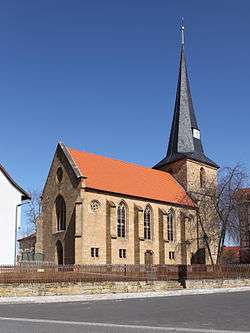Mendhausen
| Mendhausen | ||
|---|---|---|
| Ortsteil of Römhild | ||
 | ||
| ||
 Mendhausen | ||
| Coordinates: 50°22′N 10°28′E / 50.367°N 10.467°ECoordinates: 50°22′N 10°28′E / 50.367°N 10.467°E | ||
| Country | Germany | |
| State | Thuringia | |
| District | Hildburghausen | |
| Town | Römhild | |
| Area | ||
| • Total | 9.96 km2 (3.85 sq mi) | |
| Population (2013-10-31) | ||
| • Total | 310 | |
| • Density | 31/km2 (81/sq mi) | |
| Time zone | CET/CEST (UTC+1/+2) | |
| Postal codes | 98630 | |
| Dialling codes | 036948 | |
| Vehicle registration | HBN | |
| Website | www.mendhausen.de | |
Mendhausen is a village and a former municipality in the district of Hildburghausen, in Thuringia, Germany. Since 31 December 2012, it has been part of the town of Römhild.
Geography
Mendhausen is located in the southwest of Römhild at the Thuringian-Frankish border on a higher plateau of the Thuringian Rhön. The country roads 3029 and 508 connect the city traffic as standard with the surrounding area.
“In the morning this attractive village is bordered on the east parish of Römhild, of which it is an hour away, at lunchtime Irmelshausen, in the evening Rothausen and the deserted village Eichelbrunn and midnight at the Mönchshof..." Thus, the location of the village Mendhausen is described in the "Historical and statistical description of the Ducal Saxon Community Office Römhild" of 1795.
History
Mendhausen is a classical Frankish scattered village with a church in the middle. It was originally surrounded by walls for threatening times, called Gaden (storage rooms). In 1796 the village had 280 inhabitants, with 69 hearths (households). The troubled times, especially during the 30 Years War, reduced the population by more than 60%. The story that probably started in the 7th or 8th century is not known exactly. Mendhausen was probably one of the three Höchheims which history started in 783 (Great Hoechheim = those of the present Hoechheim, Small Hoechheim = Mönchshof) with the Frankish nobles, the Countess Emhilt, that just this year a number of possessions and "property" the of her founded Kloster Milz made over. 799 they inherited the possessions and the Kloster of Milz to the Bonifaciuskloster Fulda. The first Attribution "Mentehusen" comes from a deed of 1156 (Count Poppo of Irmelshausen, a Henneberger line). Similarly, in the 12th century of a chapel of the parish Mellrichstadt is the talk of it. In Mendhausen was the first church, it was the mother church of Römhild until 1405. “Agriculture was the main food source of residents also something spinning, bleaching, Livestock and wine ..." and from 1710 to 1918, the Duchy of Meiningen governs Mendhausen Mendhausen belongs to the district of the Möhnshof, which plays a significant role in the historical development of Mendhausen. The Mönchshof was mentioned in a document, at the time of Charles the Great, in conjunction with the Benedikterinnenkloster of Milz and the abbess Emhild in 783. Charlemagne was often a guest at the Mönchshof.
The village developed itself and the population grew. In 1897 the new school next to the church, built in the vicinity of the much earlier constructed communal bakehouse. A tavern, three toy shops, a wheelwright and a blacksmith were available to about half of the last century. Mendhausen was always a farm, a farming village. In the 1950s and 1960s the collectivization of agriculture, which led to the elimination of individual peasant farms. In 1969, a dairy farm of 400 LPG arose. In the same year, the work began on the construction of the water line. A short time later, was the construction of the sewage system. In own performance of the citizens of Mendhausen in the years 1968 to 1972 the House of Culture arose, which is still used today for all events. In addition, developed in close another divisions and athletes home and a point of sale, in which the youth club was established later. After 1990, an apartment building area has been developed of this particularly the young families’ make heavy use. In 1988 the Möhnchshif should be leveled, which could be prevented by the opposition of some citizens. Meanwhile the estate to its former beauty is back.
Life in Mendhausen
An active club activity provided and still provides for a good coexistence. The sports club commits its 100th anniversary in 2011. The FFW was founded in 1875. Their own initiative to the members built their old shed in 2010 so that it fulfils today's requirements. The fair society preserved by the continuation of the costume carnival traditions. After many years of break, the women took the founding of a Carnival Club in her hands and 11 elves are now over 10 years in the fools’ time with great success the scepter. The home club founded in 1999 and maintains and preserves traditions and testimonies from more recent times but also younger. The newly restored with the help of grants bakery and a small village museum are used and obtained by the club members and are available for bakery and museum hard at the center of club activity. Today, the handsome, beautifully restored village is a residential village with a lively community life, from the remoteness of the village, which lay directly on the ill-fated German border, today there is nothing to feel, a cosmopolitan spot in the middle of Germany as an idyllic location in the Green Belt the former border strip in the district of Hildburghausen.
